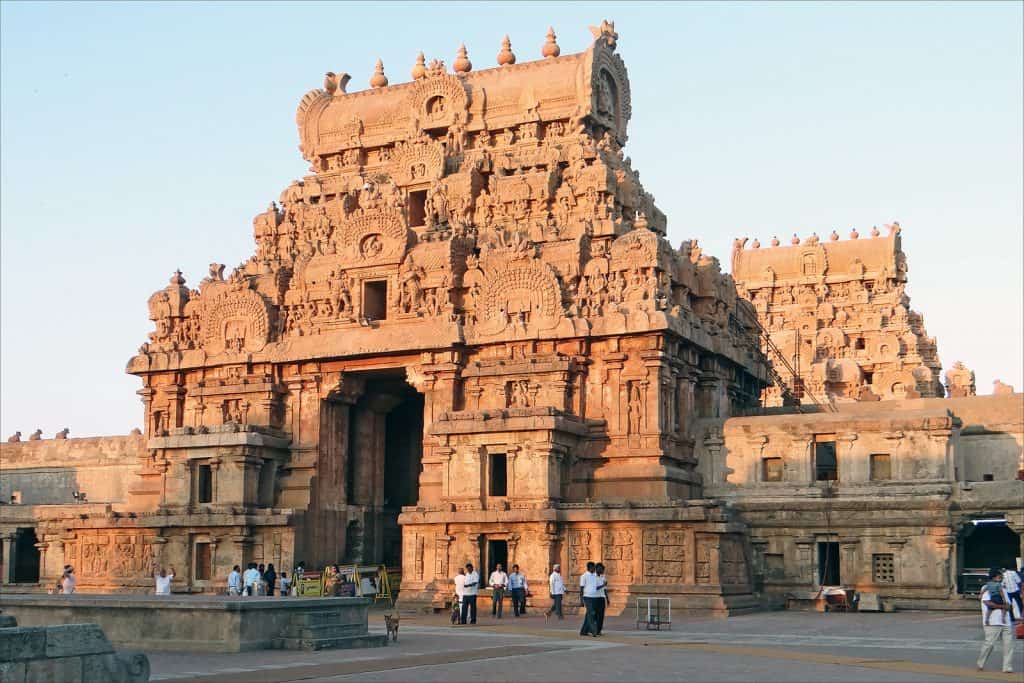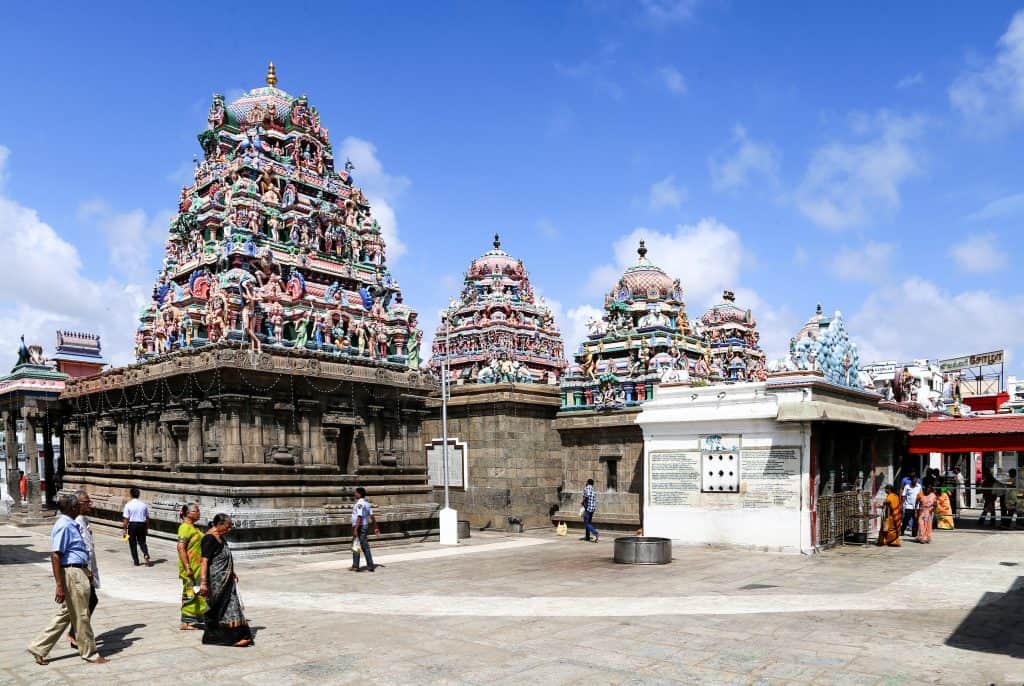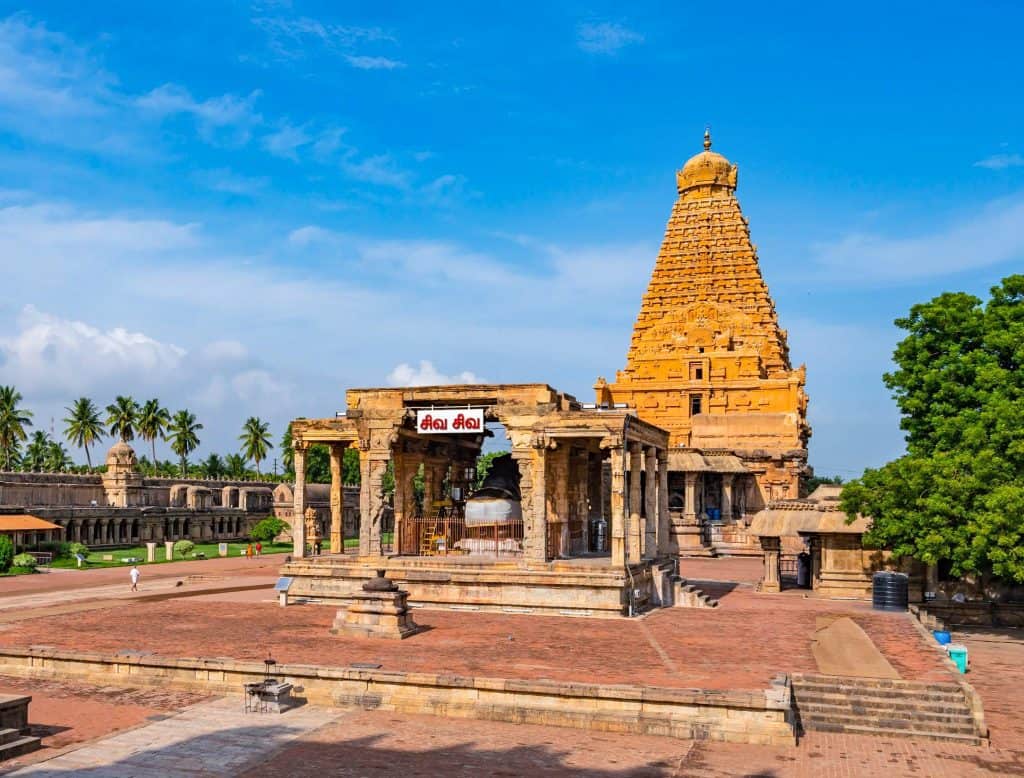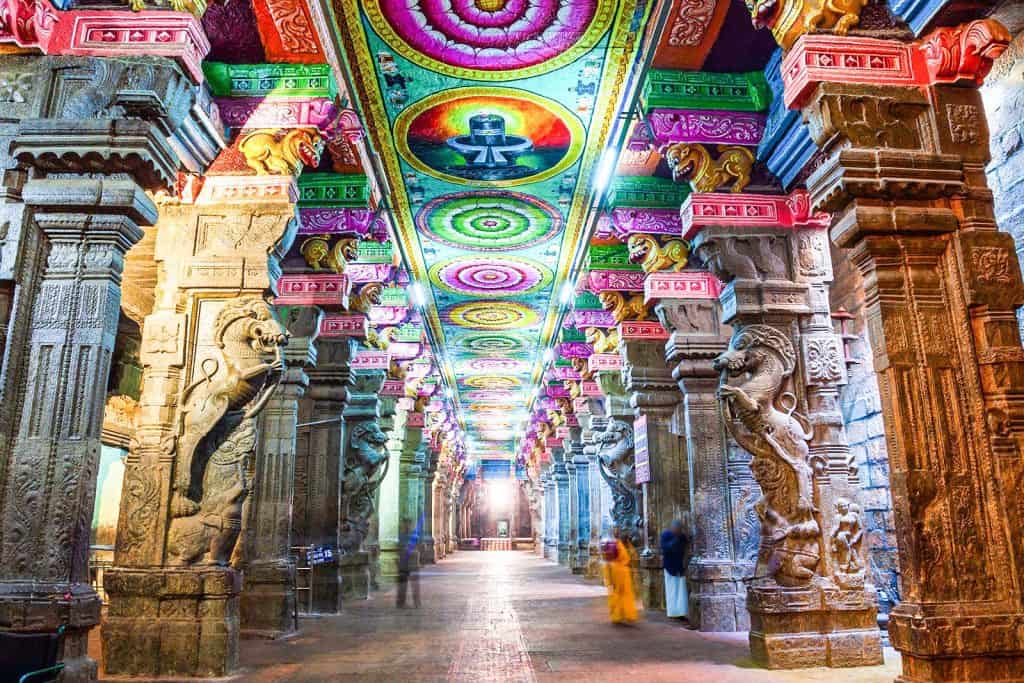Discover the beauty of the temples of Tamil Nadu, where ancient architecture and spiritual heritage blend to create awe-inspiring sanctuaries that captivate the hearts of visitors worldwide.

The state of Tamil Nadu is renowned as the “Land of Temples.”
Tamil Nadu’s famous temples have long been a subject of awe for individuals all over the globe.
With over 33, 000 temples, Tamil Nadu boasts several notable names among India’s finest and most venerated temples.
Aside from being ageless structural marvels, these locations hum with heavenly power, attracting millions of visitors during the year. The coastal state’s temples are a foundation of historical stories, cultural events, and tourism itineraries.
Among these, the UNESCO World Heritage Sites like the Great Living Chola Temples stand as a testament to the grandeur of Tamil Nadu’s temple architecture.
As you step into the cool, stone corridors, you are transported to a world of ancient rituals, timeless art, and divine energy.
Whether it’s the majestic Meenakshi Amman Temple in Madurai, the serene shore temple of Mahabalipuram, or the vast temple complex of Rameswaram, temples of Tamil Nadu offer a unique glimpse into the soul of the south.
Visiting these temples is a journey through the spiritual and architectural legacy of Tamil Nadu, leaving visitors in awe of its ancient wisdom and beauty.
Kapaleeswarar Temple, Chennai
The Kapaleeshwarar Temple in Chennai is a recognized temple in Tamil Nadu. The Amrirulgu Kapaleeswarar temple, built in the seventh century, is devoted to Goddess Parvati in the guise of Karpagambal, or the ‘Goddess of the Wish-Yielding Tree,’ and Lord Shiva. Heavenly bliss is all-encompassing for a pilgrim to the temples of Lord Shiva. The Gopuram, the temple’s primary sanctuary, is a one-of-a-kind masterpiece of Dravidian architecture.

The markings on the temple grounds originate from the 12th century.
All year round, people go to the Kapaleeswarar temple to perform six types of pujas: Ko pooja, Vaikarai Pooja, Kaala sandhi Puja, Uchi Kala Pooja, Evening Puja, Kala Puja, and Ardhajama Pooja.
The temple grounds host big events such as Brahmotsavam or ‘Arupathumoovar’ Festival, Theppa Thiruvizha Float Festival, Navratri Festival, and Vasanta Utsavam.
Brihadeeswarar Temple, Thanjavur
Thanjavur’s Brihadeeswarar shrine is a 1002-year-old temple devoted to Lord Shiva, with 100s of statues of the deity. The massive statue of Lord Shiva with three eyes is a sight to see. Rajaraja Chola I, the Chola Emperor, erected it around 1010 AD. This is India’s biggest temple, also referred to as “Thanjavur Periya Kovil.” The temple was built with around 130,000 tonnes of stone and exemplifies the Cholas’ structural brilliance and magnificence.

The 216-foot-tall Vimana (tower) is the world’s tallest. One of the greatest sculptures of its sort is a 16-foot-long and 13-foot-high figure of Nandi (Lord Shiva’s holy bull) sculpted out of a small stone. On the temple grounds, there are 250 lingams (representatives of Lord Shiva) and statues depicting his 108 dancing poses. UNESCO designated it a World Heritage Landmark in recognition of its outstanding architectural quality.
Meenakshi Temple, Madurai
The Meenakshi Sundareswarar Temple is situated in Madurai and is considered one of the greatest temples in Tamil Nadu, India. Worshippers visit the temple to seek the blessings of Lord Shiva, as Sundareswarar, and his spouse, Goddess Parvati, as Meenakshi. The complex contains 14 exquisite Gopurams, including two golden Gopurams lavishly sculpted and decorated for the principal deities.

The Nayak dynasty established the current temple in the 17th century A.D. The Meenakshi Amman temple Madurai is a magnificent work of art with a wonderful structure. Devi Meenakshi’s figure is supposed to be crafted from pure emeralds. As per the temple’s tradition, the wedding of the divinity Meenakshi to Shiva happened in Madurai and is now commemorated with tremendous zeal every summertime.
Ramanathaswamy Temple, Rameshwaram
The Ramanathaswamy temple at Rameshwaram, positioned on Pamban Island, is among the oldest shrines in Tamil Nadu. The temple holds one of the 12 Jyotirlingas and is a part of the Char Dham holy places. According to mythology, Lord Rama bowed to Lord Shiva at Rameshwaram to beg for his miracles and forgiveness for killing his most devoted disciple. The temple has a sandstone linga constructed by Lady Sita, Lord Ram’s wife, known as Ramalingam, and a Lord Hanuman transported from the Himalayan region known as Vishwalingam.
The Ramanathaswamy temple features the world’s longest hallway, which is around 3000 feet long. The temple also has 22 teerthams, or sacred river systems in the shape of reservoirs and wells. These teerthams depict Rama’s quiver’s 22 arrows. Bathing is required for all devotees before accessing the inner Sanctorum. Across the year, global travellers are inspired by Rameshwaram’s stunning setting and exquisite ambience.
Kumari Amman temple, Kanyakumari
Kumari Amman Temple is situated on the coast of Kanyakumari, at the meeting point of the Indian Ocean, Arabian Sea, and the Bay of Bengal. People pay a visit here to offer their prayers to Kanyakumari, the Virgin Goddess, an avatar of Parvati. According to historians, the Temple was erected in the 8th century by the Pandya monarchs and then restored by the Vijayanagar, Nayaka, and Chola emperors. As per the cultural tradition, Goddess Kanyakumari’s temple is devoted to the destroyer of evil, Banasura, the wicked ruler.
To earn Lord Shiva’s permission to marry, the goddesses portrayed great devotion. Sage Parashuram is also said to have placed the bluestone statue of Goddess Kanya. The Devi is portrayed in meditation, holding a garland and a dazzling nose gem in her right hand. Kanyakumari Temple is one of the most magnificent temples in India as it also draws people from all around the globe.
Naganathaswamy Temple, Thanjavur
Naganathaswamy Temple is one of the Navagraha Temples and is one of the most well-known temples in Tamil Nadu. Folks from all across the nation come to the temple to get relief from Rahu Doshas. Devoted to Sri Naganathaswamy and His companion Giri Gujambika, this is the sole temple where Almighty Rahu is housed in a human figure, as opposed to his snake version in other temples.
As per mythology, Lord Rahu came here on the day of Shivaratri to free himself from the wrath of a rishi. Suriya Pushkarani, Prugu Theertham, Gowthama Theertham, Kannuva Theertham, Parasara Theertham, Indira Theertham, and Vasishta Theertham are among the twelve holy water sources in this region. A bath in the sacred waters is claimed to heal one of the ailments and bring good fortune. It also purges negative karma and eventually offers enlightenment.
Nataraja Temple, Chidambaram
The Thillai Nataraja temple Chidambaram, one of the most prominent temples of Tamil Nadu, is situated near the centre of Chidambaram’s temple town. This temple is among the Pancha Bhoota Sthalas, each of which represents one of the five natural elements, akasha (aether). The temple complex is situated across 50 acres and was erected during the reign of the Pallava/Chola monarchs. The temple honours Lord Shiva in the guise of Nataraja and Lord Govindaraja Perumal.
This is one of the very few temples in which both Shaivite and Vaishnavite idols are housed. Another very notable highlight is Lord Shiva’s Ananda Tandava pose. One of the roots of Bharatanatyam is this heavenly dance position. In the temple compound, there are also plaster representations of 108 Bharatha Natyam Dance positions. Every tourist is inspired by the temple’s magnificent ambience and rich sculpting tradition.
Ekambareswarar Temple, Kanchipuram
Kanchipuram’s Ekambareswarar Temple is one of the greatest Shiva temples of Tamil Nadu. and regarded as the most important of the nation’s seven major pilgrimage sites. The Ekambareswarar Temple is among five great Shiva temples known as Pancha Bootha Sthalams, each symbolizing a different natural component. As the revered god is the Prithvi Lingam, this shrine signifies the aspect of Earth.
According to mythology, Devi Parvati, the spouse of Lord Shiva, worshipped a Prithivi Lingam made of sand underneath a mango tree. The temple’s exquisite ambience is well worthy of your attention. Devotees come here to discover why it is one of the most frequented temples in the world and marvel at the legendary legends, architecture, and exquisitely delightful surroundings.
Mahabalipuram Shore Temple
The Mahabalipuram Shore Temple temple was built on the sands of Mahabalipuram on the Coromandel Coast near the Bay of Bengal and is known as one of the most stunning temples in Tamil Nadu. The temple is recognized as a UNESCO World Heritage Site and is well-known for its magnificent architecture. It was constructed in the 7th century, reflecting the rich tradition of the Pallava dynasty. The temple, battered by wind and water, has seen India’s significant events. Shore Temple has three temples, the most important of which are devoted to Lord Shiva and Vishnu.
The temple is decorated in stunningly realistic and artistically crafted depictions of ordinary life. Shore Temple is no longer an active temple. It is regarded as a living testament to the Pallava Dynasty and its artistic excellence. The holy site is now the backdrop for the Mahabalipuram Dance Festival, conducted annually in January/February. The event was developed to encourage both traditional dance and the tourist industry in Mahabalipuram.
Kanchi Kailasanathar Temple, Kanchipuram
Kanchipuram is popular for its sarees, but it is also home to the Kanchi Kailasanathar Temple. If you enjoy design, the Pallava Dynasty’s artistic brilliance could well be observed here. The Dravidian contemporary design is worth getting the impression of. It is among the most important Tamil Nadu temples, dating from the late seventh and early eighth centuries. Sandstone sculptures may be found throughout the temple.
It has been one of the ancient Shiva temples in Tamil Nadu, with a 16-sided Shivling built of black granite. The 58 tiny Shiva shrines within the temple complex are not to be missed. The artistically crafted sculptures of Lord Shiva and Goddess Parvati in various dancing poses can now be seen. It is the relic of the Pallava Dynasty, which attracted millions of devotees, particularly on Maha Shivratri every year.
These temples, revered as much for their divine significance as for their historical and architectural grandeur, serve as pivotal landmarks in the cultural and spiritual landscape of Tamil Nadu. They are the epicentres of a vibrant tapestry of traditions, stories, and festivals that continue to draw millions of devotees and tourists from around the globe.
Beyond their religious allure, these temples are custodians of the rich historical narratives and cultural festivities that shape the identity of Tamil Nadu. As living monuments of faith and artistry, they offer a serene sanctuary to those seeking solace and a spectacular spectacle to those enthralled by their timeless beauty.
Read more: Latest



